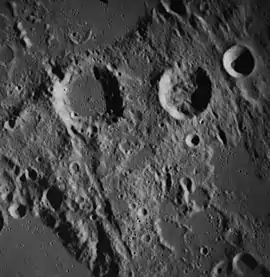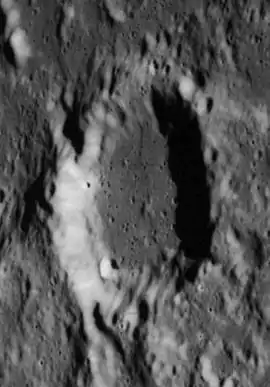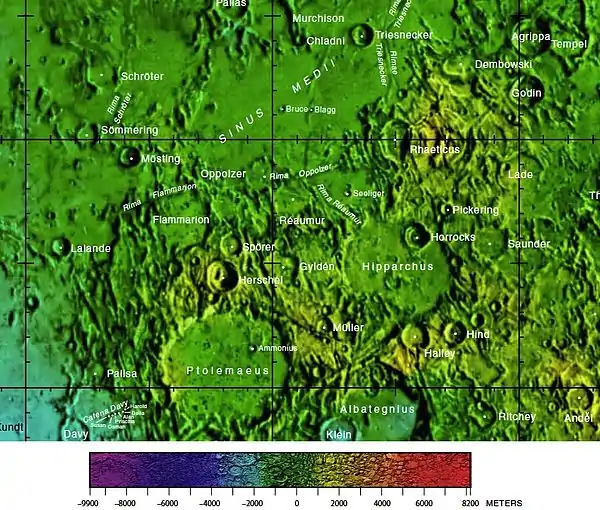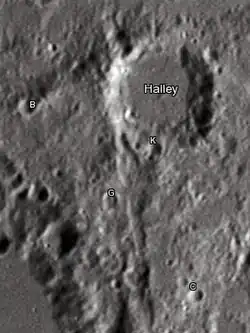Halley (cráter)
Halley es un cráter de impacto lunar superpuesto a la pared sur de la llanura amurallada del cráter Hipparchus. Al suroeste de Halley aparece el gran cráter Albategnius y al este se halla Hind, un poco más pequeño.
Cráter lunar | ||
|---|---|---|
 Halley (arriba izquierda) y Hind (arriba derecha) desde el Apolo 16. Foto NASA. | ||
| Coordenadas | 8°00′S 5°42′E | |
| Diámetro | 36 km | |
| Profundidad | 2.5 km | |
| Colongitud | 355° al amanecer | |
| Epónimo | Edmond Halley | |
|
Localización sobre el mapa lunar | ||

En el mapa de 1645 realizado por Michael van Langren, el cráter se denomina Gansii, ("de los gansos" en latín), un homenaje al relato del obispo e historiador británico Francis Godwin (1562–1633) titulado "The Man in the Moone" (El Hombre en la Luna), en el que su protagonista, el español Domingo Gonsales, alcanza la luna mediante una nave remolcada por estas aves.[1]
 Localización de Halley (abajo a la derecha) |
El borde del Halley está erosionado, y una hendidura de la superficie lunar atraviesa el sector occidental del borde, formando un valle que discurre hacia el sur-sureste, hasta acercarse al borde de Albategnius. El piso interior de Halley es relativamente plano.
Cráteres satélite
Por convención estos elementos se identifican en los mapas lunares colocando la letra en el lado del punto central del cráter más cercano a Halley.
 Cráteres satélite |
| |||||||||||||||
Véase también
Referencias
- Poole, William (2009), «Introduction», en Poole, William, ed., The Man in the Moone, Broadview, pp. 13-62, ISBN 978-1-55111-896-3.
- (WGPSN), IAU Working Group for Planetary System Nomenclature (13 de febrero de 2013). «Gazetteer of Planetary Nomenclature. 1:1 Million-Scale Maps of the Moon» (en inglés). UAI / USGS. Consultado el 6 de abril de 2016.
- Andersson, L. E.; Whitaker, E. A., (1982). NASA Catalogue of Lunar Nomenclature (en inglés). NASA RP-1097.
- Blue, Jennifer (25 de julio de 2007). «Gazetteer of Planetary Nomenclature» (en inglés). USGS. Consultado el 2 de enero de 2012.
- Bussey, B.; Spudis, P. (2004). The Clementine Atlas of the Moon (en inglés). Nueva York: Cambridge University Press. ISBN 0-521-81528-2.
- Cocks, Elijah E.; Cocks, Josiah C. (1995). Who's Who on the Moon: A Biographical Dictionary of Lunar Nomenclature (en inglés). Tudor Publishers. ISBN 0-936389-27-3.
- McDowell, Jonathan (15 de julio de 2007). «Lunar Nomenclature» (en inglés). Jonathan's Space Report. Consultado el 2 de enero de 2012.
- Menzel, D. H.; Minnaert, M.; Levin, B.; Dollfus, A.; Bell, B. (1971). «Report on Lunar Nomenclature by The Working Group of Commission 17 of the IAU». Space Science Reviews (en inglés) 12: 136.
- Moore, Patrick (2001). On the Moon (en inglés). Sterling Publishing Co. ISBN 0-304-35469-4.
- Price, Fred W. (1988). The Moon Observer's Handbook (en inglés). Cambridge University Press. ISBN 0521335000.
- Rükl, Antonín (1990). Atlas of the Moon (en inglés). Kalmbach Books. ISBN 0-913135-17-8.
- Webb, Rev. T. W. (1962). Celestial Objects for Common Telescopes, 6ª edición revisada (en inglés). Dover. ISBN 0-486-20917-2.
- Whitaker, Ewen A. (2003). Mapping and Naming the Moon (en inglés). Cambridge University Press. 978-0-521-54414-6.
- Wlasuk, Peter T. (2000). Observing the Moon (en inglés). Springer. ISBN 1-85233-193-3.
- «Lunar Impact Crater Database» (en inglés). Lunar and Planetary Institute (USRA). Consultado el 12 de septiembre de 2017.
Enlaces externos
- Referencia UAI del CRÁTER
- LPI Digital Lunar Orbiter Photographic Atlas of the Moon
- Mapa LROC
 Wikimedia Commons alberga una categoría multimedia sobre Halley.
Wikimedia Commons alberga una categoría multimedia sobre Halley.
